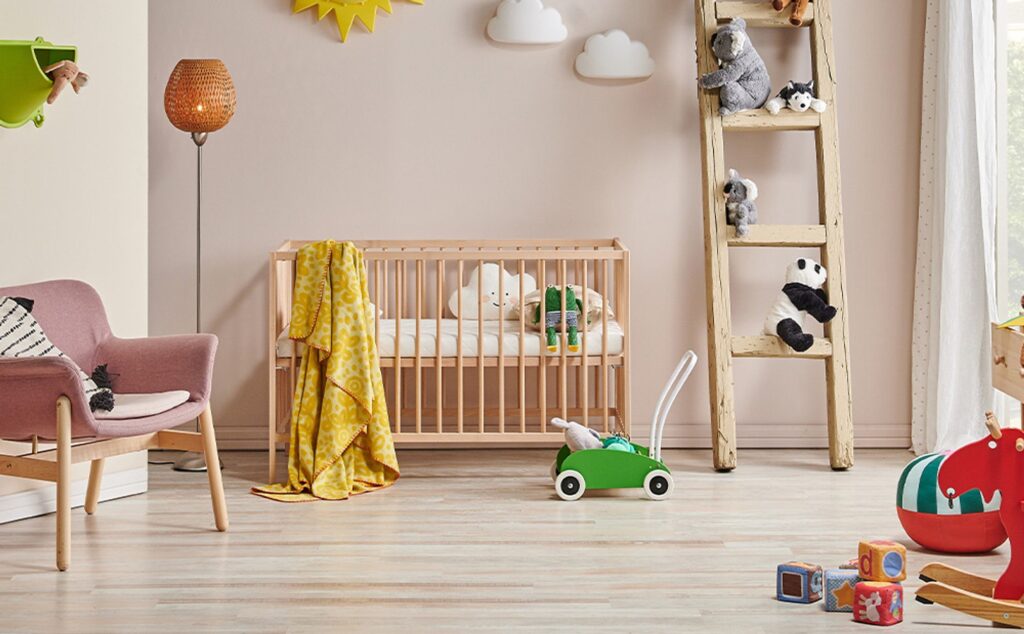
When parents begin designing their little ones’ rooms, it’s easy to get swept away by all “the stuff.” More often than not, bedroom design ideas for kids often begin with primary colors and end somewhere around the latest and greatest that Disney has to offer. Throw in a few hundred toys and curtains that “let in light,” and parents think they’re set. The problem is that while this type of room design may look cute and on-trend, your little ones’ sleep space may not be conducive to sleep. Ahead, we share some tips to help you design a bedroom for your child — and their sleep.
Long Story Short
- Your child’s environment can have a profound impact on their sleep quality and duration.
- Parents should keep good sleep hygiene in mind when considering bedroom design ideas for kids. Your child’s room should be cool, dark and quiet.
- A relaxing sleep environment has several components that parents should consider, including temperature, sound, light, and clutter.
Minimize Clutter
Christine Brown, lead child sleep consultant and founder of Bella Luna Family tells Sleepopolis, “parents may have heard that adults should sleep in a clutter-free room, but we don’t often think about our children’s sleep spaces.” The truth is when we’re designing a bedroom for better sleep, keeping the clutter to a minimum is an important piece of the puzzle — regardless of age.
According to a 2022 study, a child’s physical environment is proven to be a predictor of their sleep outcomes. (1) Ultimately, researchers found that poor-quality sleep environments (and the wider home environment) were associated with “later sleep schedules, more variable sleep schedules, shorter sleep durations, and more parent-reported sleep problems in young children.” While the study looked specifically at overall household clutter, we suspect that clutter surrounding your child as they sleep won’t do them any favors either.
Sleep problems affect 25 percent of typical developing children and 80 percent of those living with special needs.
Decluttering your child’s home may ease their minds for better sleep quality (2). The idea is to limit the excess of what they own. “To improve your child’s sleep, parents should look to remove anything that isn’t needed in the room and use bins and baskets to organize the items that need to stay,” Brown says.
Pro tip: Keep bins and baskets low and accessible so the little ones can help with clean up at the end of their day.
Choose Blackout Curtains for Bedtime
“Light tells our bodies it is time to be awake, and darkness tells our bodies it’s time for sleep,” says Brown. Artificial lights from screens or bedroom lights may disrupt this process since the body thinks it needs to stay awake. (2)
While light, airy curtains might top the list of bedroom design ideas for kids, they don’t do much to keep the light out, which means they do very little to promote sleepiness. Brown’s advice to parents: “Step away from the gorgeous sheer curtains.”
Sleep problems affect 25 percent of typical developing children and 80 percent of those living with special needs. Using blackout curtains is a great strategy to help with sleep quality (3).
When looking for blackout curtains, Brown says parents may want to:
- Go for opaque curtains (they don’t let any light through).
- Invest in wraparound rods that don’t have finials at the end so light won’t seep in the side of the curtain. Wraparound rods allow the curtains to be placed right against the wall.
- Ensure that the blackout curtains go to the floor so light doesn’t sneak in under the curtains.
Pro tip: Make sure your blackout curtains pass the hand test. Stand in your child’s room with the lights out and blackout curtains closed. In a sufficiently blacked-out room, you shouldn’t be able to see your hand in front of your face.
Invest in Good Bedding
Good bedding can make all the difference in your child’s sleep quality. If you have older children — at least preschool age or older — you might even consider a weighted blanket. Studies show laying with a weighted blanket before bedtime increases the production of melatonin and oxytocin (4), which means children may become sleepy and feel less anxious. Just make sure you’re taking your child’s body weight into account when you choose the weight of the blanket, and feel free to check with your child’s pediatrician if you have any questions.
Your child may also try different blankets to see which feels the coziest. For example, comforters are loftier, like a cloud. Quilts are flatter but more cooling than a comforter. Finding the right bedding may also depend on the time of year. Colder months may need warmer sheets and thicker covers.
While blankets, pillows, and stuffed toys are fine for toddlers and older kids, It’s important to follow the safe sleep guidelines issued by the American Academy of Pediatrics — babies under one shouldn’t have anything in the crib but a firm mattress and a fitted sheet. (3)
Pro tip: “We want to avoid any loose bedding or toys [for babies],” says Brown. “Instead, parents should look for a good quality sleep sack… to keep their baby comfy and cozy.”
Create a Relaxing Atmosphere
While we’ve already talked about light and clutter, parents should know that temperature and noise are two additional and equally important contributors to a relaxing sleep environment for their little one.
A comfy room temperature for sleep is typically about 65 to 68 degrees F, though preferences may vary from person to person and can also depend on how heavy your pajamas and bedding may be. You might opt for an oscillating fan to keep the air in your child’s bedroom moving at night, or you could invest in some lightweight, breathable bedding.
Additionally, good sleep hygiene tells us our rooms should be quiet, but some parents may opt for white noise in their children’s rooms. Some research shows white noise can help us experience better sleep, so it may be worth a shot with any restless kiddos! (5)
Some music may also help induce sleep, as it may be effective if it is comforting, blocks out unwanted noise, or is a routine habit for your child (6).
Pro-tip: Experts recommend white noise machines be kept at least 30 cm away from the child. Excessive white noise may lead to noise-induced hearing loss and other adverse health effects in infants (7).
Use a Nightlight (as Needed)
Some children are more sensitive to lights than others. But, studies show that melatonin suppression by light is larger in children. This is due to the larger pupils and pure crystal lenses in their eyes(8).
Brown adds, “If your child has expressed that they are afraid of the dark, that’s when you can add a nightlight in; just make sure that you steer clear of white, blue, purple, pink, and green lights. These colors can affect sleep quality and result in difficulty settling to sleep and staying asleep. Instead, go for sunset colors like warm yellows, oranges, and reds. Red is my favorite as it doesn’t impact melatonin (our sleepy hormone) production.” (6)
Pro tip: Sunrise alarm clocks are an excellent addition to your list of bedroom design ideas for kids, as many have wind-down and wake-up lights that eliminate the guesswork for parents.
FAQs
How can parents make a child’s bedroom suitable for sleep and play?
Ensure all toys have an organized place in the room. This will lessen a child’s desire to play with them. Also, ensure the child refrains from eating or watching screens while in bed. Keeping the bed just for sleep may help improve their nightly routine.
The Last Word From Sleepopolis
While bedroom design and decor are often a great way to spoil and delight your children, it’s important not to lose sight of their bedroom’s primary purpose: sleep. Ideally, parents should keep it quiet, keep it cool, and keep it simple.
Sources
- Hoyniak CP, Bates JE, Camacho MC, et al. The physical home environment and sleep: What matters most for sleep in early childhood. J Fam Psychol. 2022;36(5):757-769. doi:10.1037/fam0000977
- U.S. Department of Health and Human Services. (n.d.). Your sleep/wake cycle. National Heart Lung and Blood Institute. https://www.nhlbi.nih.gov/health/sleep/sleep-wake-cycle
- Rachel Y. Moon, Rebecca F. Carlin, Ivan Hand, THE TASK FORCE ON SUDDEN INFANT DEATH SYNDROME AND THE COMMITTEE ON FETUS AND NEWBORN; Sleep-Related Infant Deaths: Updated 2022 Recommendations for Reducing Infant Deaths in the Sleep Environment. Pediatrics July 2022; 150 (1): e2022057990. 10.1542/peds.2022-057990
- Centers for Disease Control and Prevention. (n.d.). Improve sleep: Tips to improve your sleep when times are tough. Centers for Disease Control and Prevention. https://blogs.cdc.gov/niosh-science-blog/2020/06/29/sleep-hwd/
- Matthew R. Ebben a, a, b, AbstractIntroductionUndisturbed sleep has been shown to be important for both health and quality of life (Medic et al. [7]). The World Health Organization estimates that nearly 25% of the population suffers from disturbed sleep due to environmental noise , Stanchina, M. L., Vallet, M., Basner, M., TWECfEa, H., Halonen, J. I., Johnson, D. A., Medicine, A. A. of S., AAoS, M., Medic, G., Hume, K. I., & Griefahn, B. (2021, April 6). The effects of White Noise on sleep and duration in individuals living in a high noise environment in New York City. Sleep Medicine. https://www.sciencedirect.com/science/article/abs/pii/S1389945721002021
- Mariana G. Figueiro, AbstractIntroduction: Night work requires inversion of the natural, Badia, P., Cella, D., Rea, M. S., Sahin, L., Souman, J. L., Stimpfel, A. W., Vandewalle, G., Åkerstedt, T., Brainard, G. C., Buysse, D. J., Correa, Davis, S., Figueiro, M. G., Ganesan, S., Hansen, J., Hays, R. D., & Hopcia, K. (2020, July 10). Red light: A novel, non-pharmacological intervention to promote alertness in shift workers. Journal of Safety Research. https://www.sciencedirect.com/science/article/abs/pii/S0022437520300694
Brown, Christine. Personal Communication. November 13, 2024.



























